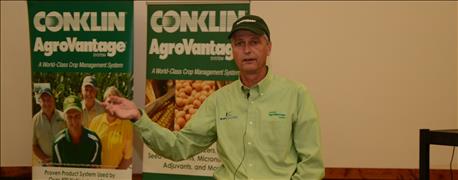
When Kip Cullers talks, farmers listen. The southwest Missouri farmer is known nationally and internationally for holding the world soybean yield record at 160 bushels per acre. But every year is different. At a Conklin Pro Grower Day in Hastings on May 17, Cullers discussed the economics of reaching higher yields in corn and soybeans during a year like this, with tight margins, and extreme weather.
This year, one of the key considerations is nitrogen management. "What's our problem? We're using too much. We're not efficient," Cullers says. "We're only using about 30% to 35% of our nitrogen we're putting out there. That's not very efficient."

THE RIGHT PLACE: Cullers recently studied how nitrogen moves through a field after it's applied. That nitrogen doesn't move as much horizontally as you might think. "Right here in the center of the row is where all the nitrogen's concentrated. On the outside of the row, right next to the corn, there's no nitrogen. If you're on 30-inch rows, you've got to move 15 inches over to the nitrogen," Culler says. "We're trying to concentrate our nitrogen to be within seven inches of the row."
We often hear about applying the right rate at the right time in the right place from the right source. Splitting up applications is step 1. According to research at various universities, growers can vastly improve nitrogen use efficiency, and in many cases yield, by applying in-season. For example, University of Missouri studies demonstrated total nitrogen applications can be delayed as late as V11 and still allow corn plants to reach full yield potential.
"Most of our nitrogen uptake is in July. If you're putting on anhydrous as soon as you harvest your soybeans in October or November and not using it until July, that's like burying money in your backyard in a fruit jar, and forgetting you put it in the fruit jar," Culler says. "That's like burning money."
Right time and place
But what about the right place? Cullers recently conducted his own research over three years in Iowa to see how nitrogen moves through a field after it's applied. Consider where nitrogen is placed when applied in different methods: when applied with a sidedress machine in the middle of the row, that's where it concentrates. As it turns out, that nitrogen doesn't move as much horizontally as you might think. Rather, it moves more vertically.
"Right here in the center of the row is where all the nitrogen's concentrated. On the outside of the row, right next to the corn, there's no nitrogen. If you're on 30-inch rows, you've got to move 15 inches over to the nitrogen," Culler says. "We're trying to concentrate our nitrogen to be within seven inches of the row."
These split nitrogen applications make a big difference for high yielders – including David Hula, who won the National Corn Growers Association yield contest in 2015 with 532-bushel corn in the no-till/strip-till irrigated category. "Do you realize 100 bushels of that yield came from pure test weight? No more kernels, no more ears, 100 bushels fell out of the sky, because he had 67 pound test weight corn," Cullers says. "That was from late season nitrogen application keeping that plant alive and growing."
Read more in an upcoming print version of Nebraska Farmer.
About the Author(s)
You May Also Like






